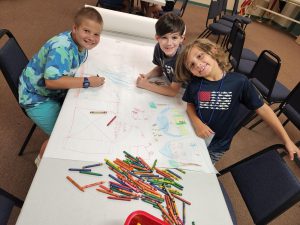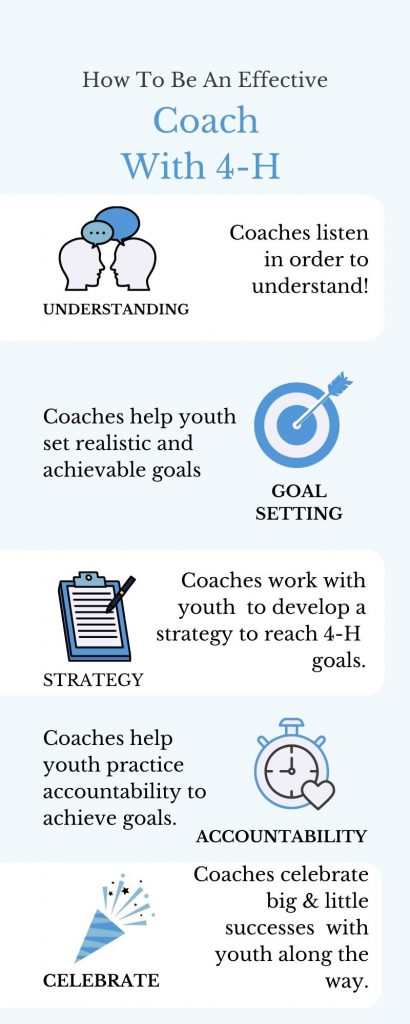by Rachel Pienta | Sep 10, 2024
Planning your North Florida Fair entry is a great way to begin the new 4-H program year. Whether you are a new or returning 4-H member, the decisions about what to enter and which category to choose for your entry may seem like big challenges. For new and returning members, Class 13 may be a great option! Class 13 is the Tabletop Exhibits entry category.
What is a Tabletop Exhibit?

This winning board explained elements of the 4-H skateboarding club.
A tabletop exhibit is either a tri-fold board or diorama that showcases your 4-H project interests. A diorama may be flat or vertical. Dioramas may be created in a shoebox or larger box or on a flat surface such as a tray. You can find ideas for your project in the Florida 4-H Events and Activities Handbook, which you can get from your club leader or local 4-H Extension office.
Tabletop Exhibit Rules
- Your exhibit must stand on its own and be no bigger than 36 inches wide by 36 inches high.
- You don’t have to buy a special display board, but a tri-fold board from an office supply store is easy to use. You can also make your own board from cardboard, but foam core or plastic boards work better because they don’t bend in humidity.
- Your tabletop exhibit should explain a part of your project, just like a science or history fair board.
Ideas for Tabletop Exhibits
- Past exhibits have featured projects like the Chick Chain and how to set up a brooder box.
- In 2023, the top prize went to a board about skateboarding safety!
- You can also make a diorama—either flat or vertical—using a shoebox or tray.
5 Steps to Create Your Exhibit
- Plan: Decide what your project will teach and what supplies you’ll need.
- Research: Learn more about your topic so you can share accurate information.
- Sketch: Draw a plan of your board to figure out where everything will go.
- Gather: Collect your materials and supplies.
- Create: Put your exhibit together!
 Preparing your Entry Form and Tag
Preparing your Entry Form and Tag
Entry forms are due to your local 4-H Extension Office by the 1st of October – check with your 4-H agent to confirm local dates. When you turn in your entry form, your 4-H agent will assign exhibit tags, which you will need to fill out and attach to your plant when it is time to submit for judging. Here is the information you need to correctly complete your entry tag:
- Section: 210
- Class: 13
- Lot: Write “A” for juniors (8-10), “B” for intermediates (11-13), or “C” for seniors (14-18).
- Exhibit: A short description of your project (e.g., “How to set up a brooder box”).
- Exhibitor: Your name
- Address: Your county
How Your Exhibit is Judged
Your exhibit will be judged on these things:
- How well it communicates your message
- Quality and appearance
- Accuracy and creativity
Judges will use this rubric to judge your tabletop exhibit. Judging happens the Wednesday before the Fair opens. You’ll get a ribbon based on your score, and you can see how you did on 4-H Day at the Fair (November 16). If you have any questions, contact your local UF IFAS Extension Office.
Resources
North Florida Fair Department 210
4-H Entry Form for Non-Animal Exhibits
Judges’ Scoring Rubric
Florida 4-H Events & Activities Handbook ‘
by Rachel Pienta | Jul 5, 2024
Fairs have been part of the 4-H youth development experience since 1902. The origins of what we have come to know as a fair can be historically documented as early as 500 BC. The earliest fairs were community celebrations to recognize religious feast days, celebrations of the harvest, and festive occasions when traveling entertainers visited towns and villages. In some communities, fairs were a source of revenue for churches.
In modern times, fairs have come to be associated with midway rides and creative fair vendor food offerings. However, for 4-H members county, regional, and state fairs are an important part of the 4-H club year. Youth members prepare exhibit entries that may include crafts, photos, baked goods, art, and models. Fairs in the United States have agricultural roots. The first fairs were organized at the county level by local agricultural societies. These fairs included competitions that featured the best livestock specimens. In the United States, the county agricultural fair tradition dates back to 1811. 4-H members may show poultry or livestock. Youth may compete in a skills or knowledge-based competition or skill-a-thon. Today’s fairs showcase agriculture with livestock competitions and exhibits. Modern fairs have added components that help connect the community to other agricultural products and may featured baked goods, canned items, honey, and more.

4-H members show off their North Florida Fair ribbons.
4-H Project Learning and the Local Fair
Positive youth development is at the heart of the 4-H experience. Fair participation can serve as a hands-on way to learn and apply life skills beyond the club setting. Youth may be earning blue ribbons while they also learning important life skills and becoming engaged members of their local community.
4-H members can enter projects in the fair in multiple categories. For example, a poultry project can be documented with a tabletop exhibit that illustrates how the project was conducted. The bird may be entered as an exhibit in the agricultural department. Photos of the bird may be entered into the photography category. Youth can design a flyer to sell eggs and enter it into the graphic design category. Other possible fair entries can be products produced as part of the 4-H learn by doing experience in clubs or summer camps. Projects can be documented through photos, graphic designs, or exhibits and all of this work can become one or more fair entries.
Preparing fair entries can be part of the 4-H year and can also serve as ways to document youth learning and, at the same time, recognize achievement. Youth can enter artwork, poetry, crafts, constructed models, collections, and baked goods. Fair exhibit entries may do double duty for county and state events. For example, a photo or graphic design entry may also be used for competition in a county showcase or entered in the state contest.
Preparing to enter an exhibit, compete in a skill-a-thon, or to show a project animal at the fair can provide youth with a time-limited, concrete goal to achieve. For example, in Wakulla 4-H, club leaders kick off the club year in September with an introduction to the North Florida Fair and the ways to participate so that youth can opt to start the membership year with a fair experience. After the North Florida Fair concludes in November, club leaders encourage the youth to set their sights on preparing a presentation or entry for county showcase and state contests.

This tabletop exhibit illustrated 4-H club project learning.
Fairs and the 4-H Club Year
From the state fair to county and regional fairs, there is a fair participation opportunity available for every 4-H member. The Florida State Fair is held in Tampa each February. This fair includes agricultural science skill-a-thons, the Florida 4-H Food Challenge, and other agricultural contests.
There are a wide variety of opportunities to attend and participate in a local fair throughout the Florida Panhandle and Big Bend region. Some fairs limit entries to one county or multiple counties while other fairs allow any 4-H member to enter exhibits or competitions. Some fairs may also have a dual FFA component. It is not uncommon for Future Farmers of American (FFA) and 4-H members to be in the same agricultural shows together.
The Washington County Youth Fair spans late February into early March. The Santa Rosa County Fair is held annually in April. The Northwest Florida Fair is held in Fort Walton Beach in September. The Walton County Fair is also held in September in DeFuniak Springs. The Central Panhandle Fair is held annually October in Bay County. The Pensacola Interstate Fair is also held in October in Escambia County. While the North Florida Fair in Tallahassee closes out the fair calendar year in November, the 4-H club year has only just started!

North Florida Fair 4-H photo entries.
For more information about 4-H and how to become involved with clubs, camps, and fairs, find your local Extension office in any Florida county.
The Institute of Food and Agricultural Sciences (IFAS) is an Equal Opportunity Institution authorized to provide research, educational information, and other services only to individuals and institutions that function with non-discrimination with respect to race, creed, color, religion, age, disability, sex, sexual orientation, marital status, national origin, political opinions, or affiliations. U.S. Department of Agriculture, Cooperative Extension Service, University of Florida, IFAS, Florida A&M University Cooperative Extension Program, and Boards of County Commissioners Cooperating.
Resources
4-H and the County Fair
Agricultural Tradition
Fairs Provide Life Skills for 4-H Youth
History of Fairs
List of Select Florida Fairs
Motivation for and Developmental Benefits of Youth Participation in County 4-H Fairs: A Pilot Study
Why Are Fairs So Important to 4-H?
by Rachel Pienta | Jul 28, 2023
While returning to school may be exciting to some children, for others the back-to-school season is a time of anxiety and heightened stress. Whether you are a parent or an adult who works closely with youth, there are steps to take that can help young people manage stress and build a foundation for school success.
In my role with 4-H, I serve as a member of University of Florida faculty specializing in youth development and volunteer systems in the Wakulla County Extension office. My work involves collaborating with and supporting local youth, their families, adult volunteers, and community partners. This summer, I completed Mental Health First Aid Training, a program offered by the National Council for Mental Wellbeing. This training is available to any interested adult or teen. Visit this site for more information: https://www.mentalhealthfirstaid.org/. The training was an excellent refresher that helped bring me up to date on ways to support youth and families in our community. Mental health concerns often differ by age. What may be worrisome to your elementary school aged child has will likely differ from what will trouble your high school aged teen.
Getting the Conversation Started
Over the course of twenty-eight years and counting as an educator, I have had the opportunity to work with youth and young adults ranging from pre-school to college. The one concern I can confidently say that

The new school year is about to start!
youth of any age are likely to share is a fear of the unknown. While the unknowns change from year to year and differ between children, one way to handle potential worries is to talk about them. Consider these conversation starters to help your child discuss the new school year:
- What do you most look forward to experiencing/doing this school year?
- If you could change one thing about the last school year, what would it be? Why?
- What are you most hoping to learn/do this school year?
While some children will take these questions and run with them, other children may be less eager to communicate or just less enthusiastic about the new year. Parents may want to adjust their questions to address stressors that accompany back to school time and how to alleviate those concerns.
Tips for the Early Years of Elementary School
For younger children, driving by the school building may help alleviate nerves. You may not get to visit a classroom inside the school until a scheduled Open House event, but seeing the place and discussing what the school day involves can help to dispel some worry. Tips for easing the back-to-school jitters for elementary school:
- Establish the back-to-school bedtime routine. Helping to get sleep routines back on the school year schedule is a good first step to success.
- Practice the morning routine. Consider timing it. Make it a game. What steps are needed to get everyone out the door on time? Practicing this routine for a few days will help everyone make better school day decisions such as whether to lay out clothes and school supplies the night before, make lunch or snacks the night before, and can help everyone feel less stressed on school days.
- Plan for lunch and practice lunch time skills. If you are sending a packed lunch or snacks, can your child open the packages without help? Does your child like what you are sending? Involving children in planning lunch and snacks can help ensure food is eaten and not wasted.
The American Academy of Pediatrics offers helpful back to school tips for kindergarten through school on the HealthyChildren.Org page located at https://www.healthychildren.org/English/ages-stages/gradeschool/school/Pages/back-to-school-tips.aspx.
Tips to Manage Middle School
In middle school, school expectations for youth increase with each grade level. The Nemours Foundation offers advice specific to the middle school years:
- Visit the school website with your youth. Review school policies together.
- Discuss goals for the school year together. The middle school years offer opportunities to develop organizational skills and start to make choices about how to allocate their time.
- Work together to develop a realistic nutrition plan. Your middle school child may prioritize sleep over a healthy breakfast. Discussing your expectations about how and what your child eats to be well-prepared for the school will help ensure they can follow a plan that works for both of you.
For more tips about supporting your middle school student for success, visit the Nemours Kids Health web page at https://kidshealth.org/en/parents/school-help-middle.html.
Tips to Finish Strong in High School
The high school years come with a different set of stressors and the concerns your child has entering ninth grade will likely be different than the concerns they have entering senior year. For youth entering the ninth grade, high school may seem intimidating. Youth have experienced the heights of eighth grade, when they are the oldest in middle school. Then, ninth grade rolls around and students are back on the lowest rungs of the school pecking order once again. Add the pressure of an environment where grades and extracurricular activities may impact a child’s future beyond the high school years and the perfect formula for stress is created. How can parents support a newly minted high school student?
- Discuss course choices with the school course catalog as a guide. The school guidance counselor can help you locate the guide if it is not available on the school website.
- Determine what goals your child want to set. Do they want to take a language, join a school club, try out for a sport?
- Is your child leaning toward vocational studies? What requirements do they need to fulfill to enter a vocational program?
Setting academic and post-high school goals as early as eighth or ninth grade can help alleviate some stress in the final years of high school. Youth in tenth and eleventh grades will either work to maintain a positive trajectory or they will need to do self-examination to determine how to get back on a track that will get them where they want to go. Youth at this age may be considering after-school jobs or may take advantage of dual enrollment course options.
Youth entering twelfth grade, along with their families, are about to embark on an emotional roller coaster ride. High school seniors and their parents will experience a number of “last time this will happen” moments, beginning with the first day of school. The final year of high school can be bittersweet. This last year will also carry the weight of the future with it. Some youth may find themselves overwhelmed by the unknowns and the many decisions that may be facing them as they prepare for a life beyond high school. To ease some of this stress, have family discussions about the school year before classes begin. Plan on check ins throughout the year. The emotions a student may feel in August may differ significantly from what they are feeling in February when peers begin to receive college acceptances. Possible questions to ask early in senior year:
- What deadlines should we have on our calendar?
- When are payments due for college applications, senior trips, cap and gown, invitations?
- What parts of senior year do you want family members to experience and what part of senior year will be just for you and your friends? This is the time to start planning for sports or band senior nights, gatherings for Homecoming or Prom, and graduation parties.
Handling Challenges and Opportunities Together

Follow these tips to start school strong this year!
Whether you are the nervous parent of a kindergartener or the proud parent of a high school senior, the new school year will bring challenges to manage as well as opportunities to make new family memories. Planning ahead and keeping the lines of communication flowing between family members will help the school year flow more smoothly for parents and students alike. If you are looking for new youth or volunteer activities to add to your family’s routine this school year, consider contacting your local Extension office for youth activities and volunteer opportunities.
Additional Back-to-School Stress Management Resources
The American Institute of Stress. (2019). 15 Ways to Beat Back-to-School Stress. Retrieved July 25, 2023 from https://www.stress.org/15-ways-to-beat-back-to-school-stress.
Borenstein, J. (2019). Back-to-School Stress Management. Brain and Behavior Research Foundation.
Retrieved July 25, 2023 from https://www.bbrfoundation.org/blog/back-school-stress-management#:~:text=Each%20weekend%2C%20spend%20some%20time,likely%20to%20stick%20to%20them.
JED Foundation. (2023). 8 Ways to Lower Stress in High School. Retrieved July 25, 2023 from https://jedfoundation.org/resource/8-ways-to-lower-stress-in-high-school/.
by Rachel Pienta | Jun 12, 2023
Many 4-H clubs take a break during the summer months. Club leaders and youth may travel, have different summer schedules, or choose to participate in camps during the summer months. 4-H volunteers can help play a role in helping youth and families transition to summer activities. Furthermore, the transition from the club year to summer activities is an opportunity for volunteers to help lay a foundation for youth retention in the next 4-H year.
Research shows that summer activities can play an important role in youth development:
Out-of-school and summer programs can play a variety of important roles in supporting healthy development during childhood. First, out-of-school and summer programs provide a setting for children to experience supportive social relationships with both adults and peers, relationships that foster emotional, behavioral, and cognitive development. Second, such programs offer an opportunity for both structured and unstructured play, as well as a child’s choice in activities. This may be particularly important as schools increasingly focus on structured academic learning, even in the early grades (Bassok et al., 2016), and as other societal changes, such as increased parental employment and greater digital engagement decrease opportunities for unstructured play (Yogman et al., 2018).
(Hutton R. & Sepúlveda MJ, 2019)
Club Year Transitions
Club leaders may choose to close out the club year when the school year ends. This ending may involve a celebration, a recognition of achievement, or it may take the form of electronic communication with parents. It is important to close the club experience with an invitation for future 4-H engagement. This engagement may be day or residential camp, the next club year, a 4-H Open House event. Other club leaders may change the meeting schedule or offer different activities during the summer months. Youth may transition to an older age group with the new club year or may choose switch clubs as interests change. The summer months offer opportunities to help youth choose the next step in their 4-H experience. It is helpful to follow up with a club year recap email that includes summer resources and suggestions. Adding in the date of the fall 4-H Open House event and preview information about the next club year can help increase member retention from year to year.
Opportunities for Senior 4-H Youth

4-H youth receive awards recognizing achievements during 4-H University event.
If your county offers summer day camps, your 4-H agent may be able to engage high school age senior 4-H youth as volunteers. The summer volunteer camp counselor experience can play an important role for rising ninth through twelfth graders who are looking to develop valuable workforce skills and experience. An added plus for youth is that 4-H volunteer hours can count toward fulfilling the Bright Futures service hours requirement.
4-H Summer Camps
Your local Extension office likely offers a variety of themed 4-H day camps that focus on life skills. The state 4-H program also offers residential camps. Senior 4-H youth can also attend overnight events such as 4-H Legislature, 4-H University, and 4-H Grilling Camp. Intermediate youth have the option of participating in the iLead weekend. The county 4-H agent can help volunteers become well-versed in the many summer options offered by 4-H that are available for youth locally and around the state.
For more information, contact your local Extension office and bookmark the state 4-H page.

At 4-H summer day camp, youth learn about farms and design their own dream farm.
Resources for Additional Reading
Ellison, S., & Harder, A. (2018). Factors Contributing to the Retention of Senior 4-H Members: From the Youth Perspective. Journal of Human Sciences and Extension, 6(3), 10. DOI: https://doi.org/10.54718/LCJZ7328
Hutton R. & Sepúlveda, MJ, editors. (2019). Shaping Summertime Experiences: Opportunities to Promote Healthy Development and Well-Being for Children and Youth. Washington (DC): National Academies Press (US); 2019 Sep 26. 3, The Effects of Summertime Experiences on Children’s Development. National Academies of Sciences, Engineering, and Medicine; Division of Behavioral and Social Sciences and Education; Board on Children, Youth, and Families; Committee on Summertime Experiences and Child and Adolescent Education, Health, and Safety. Available from: https://www.ncbi.nlm.nih.gov/books/NBK552668/
Lewis, K. M., Hensley, S., Bird, M., Rea-Keywood, J., Miller, J., Kok, C., & Shelstad, N. (2022). Why Youth Leave 4-H After the First Year: A Multistate Study. Journal of Human Sciences and Extension, 10(3), 5. DOI: https://doi.org/10.55533/2325-5226.1429
Newby, L. & Sallee, J. (2016). 4-H Membership Recruitment/Retention Problems: A Meta-Analysis of Possible Causes and Solutions. Journal of Youth Development. 6. 37-46. 10.5195/JYD.2011.163.
by Rachel Pienta | May 26, 2023
What does it mean to be a coach? When you hear the word coach, do you picture someone with a whistle on a sports field? Most of us are probably familiar with sports coaching. However, the concept of coaching has grown to include life and professional coaching as well! This expansion of coaching has established that it is a skill that has applications across a broad array of life situations.
If you google professional coaching, you will find a plethora of books available on the topic. Writer Julie Starr has identified several fundamental coaching skills: building rapport, listening, asking good questions, and giving constructive feedback (Starr, 2021). Those skills sound like the characteristics agents hope to find in a 4-H volunteer!
How Is Coaching Different From Mentoring?
How does coaching differ from mentoring? Zust (2017) contrasted coaching versus mentoring in the business setting, explaining that coaching is a partnership between the coach and the person receiving coaching. The coach helps an individual or team reach or grow toward their potential. Just as a sports coach has a season, a coach in the business setting helps the person or team to reach a goal. How does coaching translate to the 4-H setting? In 4-H, youth may want to complete a project or compete in an event. As a volunteer, you can help coach them through a successful experience! In contrast, Zust (2017) characterizes mentoring as a longer term, developmental process that may not be focused on one particular event or project. In an earlier blog post, I addressed types of mentoring and mentoring practices.
As a volunteer, you may recognize that the 4-H agent you work with has been coaching you! As a 4-H club volunteer, you also have the opportunity to coach the youth enrolled in the 4-H program. In this blog post, you will learn about coaching techniques and how to be a more effective coach to the youth in your clubs. What does it mean to be effective as a coach? In the context of youth development, coaching effectiveness can be defined as the integrated application of “professional, interpersonal, and intrapersonal knowledge to improve youth competence, confidence, connection and character” (Vella et al, 2011).

4-H coaches help youth achieve their goals.
Getting in the Zone (of Proximal Development)
To better understand how to effectively implement coaching with youth, we will consider the following learning concepts: the Zone of Proximal Development (ZPD) and “scaffolding” (Vinson and Parker, 2019). Vygotsky (1978) defined ZPD as the “distance between actual developmental level as determined by independent problem-solving and the level of potential development as determined through problem-solving under adult guidance or in collaboration with more capable peers.” When I read Vygotsky’s definition of ZPD, I immediately think, “That’s 4-H!” Youth are able to develop and improve skills, ultimately achieving more with the support of caring adults. In 4-H, we also encourage youth to apply what they have learned through teaching others. Several coaching behaviors suggested by Vygotsky include “questioning, demonstrating and introducing the beginnings of task solution” (Vinson and Parker, 2019). These behaviors are ways to use scaffolding as a technique in youth development.
How to Incorporate Scaffolding into Your Coaching Toolkit
Scaffolding is a learning process that can be used as a technique in effective coaching. This technique can help youth build on existing knowledge they have previously acquired. The process works similarly for skill-building and “Scaffolding practices provide the opportunity for children to reach higher-level skills by building on and extending their existing skills” (Mincemoyer, 2016). Three examples of scaffolding strategies that can be used to coach 4-H youth include:
- Modeling and demonstrating: Adult volunteers can demonstrate the skill or ask a youth to demonstrate.
- Incorporating reflection into the club meeting: Build in time for youth to explain to you and their peers what they learned during a club activity.
- Using documentation: Illustrated talks and project books are forms of documentation. Youth may document their learning with photographs, written descriptions, and even video. This documentation becomes a foundation to build on moving forward as more skills are developed.
(Adapted from Mincemoyer, 2016).
In closing, you may already be engaging in effective coaching strategies as a 4-H volunteer without knowing that was what you were doing! If coaching is a new concept for you, this blog post should serve as a starting point for further development in your volunteer experience. Your 4-H agent can be an excellent knowledge resource as well as serving in a coaching role for you.
For more information about positive youth development (PYD) strategies or to learn more about becoming a 4-H volunteer, reach out to your local Extension office.

Youth engage in a mock Cooking Challenge with coach support.
Resources for Further Reading
Mincemoyer, C. (2016). “Scaffolding Approaches and Practices.” Penn State Extension. Pennsylvania State University. http://bkc-od-media.vmhost.psu.edu/documents/HO_MIL_GI_Scaffolding.pdf
Starr, J. (2021). The Coaching Manual. 5th edition. Pearson Business.
Vella, Stewart & Oades, Lindsay & Crowe, Trevor. (2011). The Role of the Coach in Facilitating Positive Youth Development: Moving from Theory to Practice. Journal of Applied Sport Psychology. 23. 33-48. 10.1080/10413200.2010.511423.
Vinson, D. and Parker, A. (2019) Vygotsky and Sports Coaching: Non-linear practice in youth and adult settings. Curriculum Studies in Health and Physical Education, 10 (1). pp. 91-106. doi:10.1080/25742981.2018.1555003 ORCID: 0000-0001-6842-3067
Vygotsky, L. S. (1978). Mind in Society: The development of higher psychological processes. Harvard: Harvard University Press.
Zust, C. (2017). “Know the Difference Between Coaching and Mentoring.” Kent State University. https://www.kent.edu/yourtrainingpartner/know-difference-between-coaching-and-mentoring
 Preparing your Entry Form and Tag
Preparing your Entry Form and Tag









